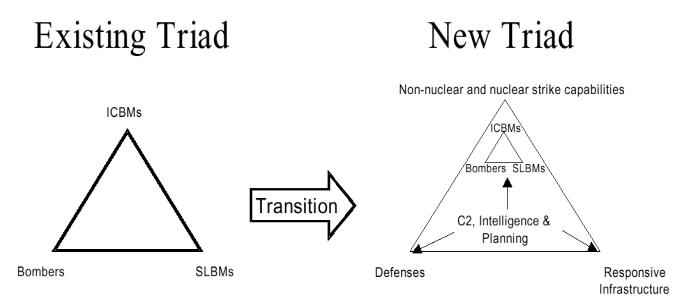
Книги / Основи військового перекладу
.pdf
According to Joint Publication 1-02, deterrence is understood as “the prevention from action by fear of the consequences. It is a state of mind brought about by the existence of a credible threat of unacceptable counteraction”41.
The Nuclear Triad
The offensive capability of the United States rests on what is known as the Nuclear Triad, comprised of strategic bombers, land-based intercontinental ballistic missiles (ICBMs), and submarine-launched ballistic missiles (SLBMs). It was devised so if any one of the three “legs” is destroyed by an attack, the other two can still function42.
The United States maintains B-52, Rockwell B-1B, and Northrop Grumman B-2 bombers capable of being armed with nuclear weapons as part of its strategic force.
The U.S. land-based ICBM force consists of Minuteman III ICBMs capable of carrying three warheads apiece and 50 Peacekeeper missiles, each deploying 10 warheads43.
Nuclear-powered ballistic-missile submarines (SSBNs) armed with long-range SLBMs will assume a greater share of the strategic nuclear deterrence mission if Strategic Arms Reduction Treaty II (START II) is implemented. Under START II, the SLBM force will provide about half of the 3,000 to 3,500 nuclear warheads the United States will be permitted to deploy. SSBNs, which are very hard to detect when at sea, are the most survivable element of the strategic nuclear triad. A significant portion of the SSBN fleet is at sea at any given time, and all submarines not in the shipyard for long-term maintenance can be deployed during a crisis. The U.S. SSBN fleet consists of 19 Ohio-class submarines. No new SSBNs or SLBMs are currently under development44.
The New Triad45
The Quadrennial Defense Review (QDR) of 2001 concluded that deterrence should not be limited to the threat of retaliation, nor rely exclusively on nuclear forces. The U.S. will need a broader range of capabilities to assure friends and foe alike of its resolve. Nuclear forces, moreover, are unsuited to many of the contingencies for which the U.S.
41Joint Publication 1-02. Department of Defense Dictionary of Military and Associated Terms. — 12 April 2001 (As Amended Through 5 June 2003). — p. 156.
42Walter J. Boyne. Defense Systems. — Microsoft ® Encarta ® Encyclopedia 2002.
43Annual Report to the President and the Congress, 1999.
44Ibid.
45Donald H. Rumsfeld. Annual Report to the President and the Congress, 2002. Chapter 7. Adapting US Strategic Forces.
— Pp. 83-92.
101101101588

prepares. A mix of capabilities, offensive and defensive, nuclear, and conventional is required.
The application of a capabilities-based approach to U.S. nuclear forces has resulted in a decision to transform the existing triad of U.S strategic nuclear forces into a New Triad composed of a diverse portfolio of offensive and defensive, nuclear, and conventional systems. The New Triad is designed to give the President and the SECDEF a broad array of options to address a wide range of possible contingencies.
There are six underlying elements that support the legs of the New Triad: strike capabilities (nuclear and non-nuclear), defenses (active and passive), infrastructure, planning, command and control, and intelligence.
Strike Capabilities. Non-nuclear strike capabilities include advanced conventional weapons systems, offensive information operations, and Special Operations Forces. Deployed nuclear strike capabilities include the three legs of the existing strategic triad and theater-based, nuclear-capable dual-role aircraft.
Defenses. Active defenses include ballistic missile defense (BMD) and air defense (AD). Passive defenses include measures that reduce vulnerability through mobility, dispersal, redundancy, deception, concealment, and hardening; warn of imminent attack.
Infrastructure. A responsive infrastructure that can augment U.S. military capabilities in a timely manner provides strategic depth to the New Triad.
102

Planning. Careful planning will be critical to integrate and balance the three elements of the New Triad. Planning for the New Triad must consider multiple goals, a spectrum of adversaries and contingencies, and the many uncertainties of the security environment.
Command and Control. A reliable, survivable, and robust command and control (C2) system will serve as a critical portion of the New Triad.
Intelligence. “Exquisite” intelligence access to an adversary’s secrets without his knowledge is essential to provide insight into the intentions as well as the capabilities of opponents. Such intelligence should enable the United States to tailor its deterrent strategies to the greatest effect.
The United States plans to reduce its operationally deployed nuclear forces over the next decade to 1,700 to 2,200 warheads, while maintaining the flexibility necessary to accommodate changes in the security environment. Reductions are planned through a phased program that eliminates Peacekeeper ICBMs, removes 4 Trident SSBNs from strategic service, and downloads weapons from Trident SLBMs, Minuteman III ICBMs, and B-52H and B-2 bombers.
The existing verification regime established by the first Strategic Arms Reduction Treaty (START I) that entered into force December 5, 1994 will remain in effect. The U.S. Senate did not provide its advice and consent to the Comprehensive Nuclear Test-Ban Treaty (CTBT). The Administration does not support ratification of the CTBT but continues to support observance of the U.S. testing moratorium.
In sum, the U.S. strategy for its strategic forces will be transformed and adapted to meet the challenges of the decades to come. The risks associated with reductions in deployed nuclear warheads will be offset by the development and fielding of non-nuclear offensive and defensive capabilities and a revitalization of the infrastructure. The new strategy puts aside Cold War practices and planning and represents an important step in defense transformation.



 Answer the questions
Answer the questions
1.What is the mission of the US Strategic Forces?
2.Can you explain the meaning of deterrence?
3.Do you agree with the statement that the risk of nuclear proliferation is higher than in the past?
4.Why are the nuclear forces referred to as the triad?
5.What are the components of the New Triad?
103103103588

6.What is START?
7.Why are SSBNs considered to be the most survivable element of the strategic nuclear triad?
8.Do you think strategic nuclear forces can guarantee peace and security?
9.Are there strategic nuclear forces in Ukraine?



 Read, decipher and translate abbreviations
Read, decipher and translate abbreviations
FSU; WMD; BM; ICBM; SLBM; CM; SLCM; SSBN; START; QDR; BMD; AD; CTBT; NPT.
|
Translate into Ukrainian |
To hold at risk classes of targets; theater-based, nuclear-capable dual-role aircraft; undertake a massive first strike (against sb); the threat of a nuclear war; to have nuclear weapons programs; provide credible capabilities; largescale conventional military force; to achieve strategic and political objectives; existence of a credible threat; offensive capability; to be armed with nuclear weapons; strategic nuclear deterrence mission; nuclear warheads; to be unsuited to many of the contingencies; a capabilities-based approach; a broad array of options; advanced conventional weapons systems; theater-based aircraft; dual-role aircraft; mobility; dispersal; deception; hardening; infrastructure; to provide strategic depth (to sth); a spectrum of adversaries and contingencies; uncertainty; command and control system; survivable; reliable, survivable, and robust command and control system; operationally deployed nuclear forces; a phased program; to meet the challenges of the decades to come; development; revitalization of the infrastructure; a major reduction in the U.S. strategic nuclear arsenal; conventional warfare; in a timely manner; nuclear-capable missiles; over the next decade; to be at sea; to be under development; to deter aggression; to enhance SSBN security and survivability; to enter inventory; to maintain nuclear forces of sufficient size and capability; with multiple warheads.









 Translate into English
Translate into English
Надійна, безвідмовна і безперебійна система військового управління; загроза тотального ядерного удару; значно зменшувати ядерні сили; розповсюдження ядерної зброї; відігравати головну роль в обороні; стримувати широке коло загроз; ядерні можливості; утримання від дій під страхом наслідків; недопустима протидія; три складові ядерної
104

тріади; покладатися виключно на ядерні сили; поєднання бойових можливостей; трансформувати існуючу тріаду у нову; відповідати за широке коло можливих кризових ситуацій; інформаційні операції наступального характеру; літак, що здатний нести ядерну зброю; вразливість; зменшувати вразливість через рухомість; дублювання (надмірність); прихованість; попередження про можливий напад/удар противника; гнучка інфраструктура; ретельне планування; стан безпеки (політ. “клімат безпеки”); безліч мінливостей, що характеризують клімат безпеки; надійний; стійкій; витривалий; непіддатливий; непохитний; безперебійний; застосовувати стратегію стримування з максимальною ефективністю; підтримувати необхідну гнучкість; існуючий режим верифікації; нейтралізувати ризики, пов’язані із скороченням розгорнутих ядерних боєголовок; прийняття на озброєння; надходження (до війська); трансформація системи оборони; обмежена здатність доставки ядерних зарядів на далекі відстані; літак, літальний апарат; дружній, дружелюбний; довготривале технічне обслуговування; підводні човни типу “Огайо”; виконувати завдання щодо нанесення ударів як ядерною, так і звичайною зброєю; бути ратифікованим; становити значні труднощі щодо виявлення; стримувати напад на США чи їх союзників; набувати чинності; тримати під загрозою; програма розробки ядерної зброї; у період після холодної війни.









 Translate quickly
Translate quickly
Ядерні сили; conventional forces; колишній СРСР; nuclear attack/strike; ядерні випробування; to deploy nuclear weapons; ЗМЗ; strategic forces;
тримати під загрозою; weapons of mass destruction; стримувати агресію; deterrence; засоби стримування; deterrent strategy; ядерна тріада; bomber;
стратегічний бомбардувальник; heavy bomber; бомбардувальник−носій ядерної зброї; conventional bomber; балістична ракета; intercontinental ballistic missile; балістична ракета підводного базування; cruise missile; крилата ракета підводного базування; land-based missile; ракета повітряного базування; sea-based missile; ракета великої дальності; warhead; підводний човен атомний з ракетами балістичними; Strategic Arms Reduction Treaty; “Чотирирічний оборонний огляд”; retaliation;
кризові ситуації; strike capabilities; ударні можливості з використанням ядерної зброї; non-nuclear strike capabilities; система (засоби) оборони; active defenses; засоби пасивної оборони; ballistic missile defense;
протиповітряна оборона; adversary; система управління військами;
Comprehensive Nuclear Test-Ban Treaty; мораторій; testing moratorium;
105105105588

розповсюдження зброї; non-proliferation; Договір про нерозповсюдження ядерної зброї; nuclear forces; звичайні (неядерні) сили; nuclear tests; розгортати ядерну зброю; to hold at risk; зброя масового знищення; SSBN; МБР; to deter aggression; стратегія стримування; nuclear triad; важкий бомбардувальник; ballistic missile; міжконтинентальна балістична ракета; submarine-launched ballistic missile; крилата ракета; air-based missile; ракета наземного базування; submarine-launched cruise missile; Договір зі скорочення наступальних озброєнь; ракета морського базування; nuclear-powered ballistic-missile submarine; ударні можливості з використанням неядерної зброї;
Quadrennial Defense Review; система активної оборони; long-range missile; ППО; contingencies; ПЧАРБ; nuclear strike capabilities; МБР; moratorium; Договір про повну заборону ядерних випробувань; command and control system; оборона проти балістичних ракет; Nuclear Non-Proliferation Treaty.



 Build up your vocabulary
Build up your vocabulary
d e f e n s e 
1. юр., спорт. захист
defense mechanism – захисний механізм defense reaction – захисна реакція
in defense of peace – на захист миру in defense – у захист, у виправдання in оnе’s defense – у свій захист
it may be said in his defense that ... – щодо його виправдання можна сказати, що ...
to make no defense against accusations – нічого не сказати у свій захист the case for the defense – захист
the counsel [witnesses] for the defense – захисник обвинувачуваного the witnesses for the defense – свідки обвинувачуваного
to conduct оnе’s own defense – відмовитися від захисника, узяти на себе захист, захищатися самому
Indian defense – шахм. індійський захист man-to-man defense – захист “гравець проти гравця” team defense – командний захист
best defense is offence – напад – кращий захист
to act in self-defense – діяти в порядку самозахисту
106

2. оборона active defense – активна оборона
air defense – протиповітряна оборона
air-defense interceptor – перехоплювач ПВО, ракета-перехоплювач, винищувач-перехоплювач
all-round defense – кругова оборона anti-tank defense – протитанкова оборона back line defense – оборона тилової смуги chemical defense – протихімічний захист civil defense – цивільна оборона
Defense Board – Рада оборони
defense expenditure – витрати на оборону defense in depth – ешелонована оборона defense tactics – оборонна тактика ground defense – наземна оборона
heavy defense – щільна оборона
line of defense – смуга оборони; оборонний рубіж linear defense – лінійна оборона
national defense – національна оборона; оборона країни self-defense – самооборона
territorial defense – територіальна оборона
the Ministry of Defense – Міністерство оборони
the system of collective defense – система колективної оборони thin defense – нещільна оборона
3. pl. укріплення; оборонні споруди; система/засоби оборони
coast defenses – берегові укріплення
to set up defenses – організовувати оборону, будувати оборонні споруди



 Translate at sight
Translate at sight
Роль ядерних сил НАТО46
Головне призначення ядерних сил НАТО залишається політичним: зберегти мир і запобігти застосуванню сили. Ядерні сили НАТО роблять ризик агресії проти Альянсу непередбачуваним і неприйнятним, чого не забезпечують звичайні (неядерні) сили. Ядерні сили НАТО стримують застосування ядерної, біологічної і хімічної
46 Адаптовано з: "Довідник НАТО. — NATO: Office of Information and Press, Brussels, Belgium, 2001." — С. 60.
107107107588

зброї сили Альянсу і, таким чином, роблять свій внесок у боротьбу із поширенням зброї масового знищення та засобів її доставки.
Колективна безпека, яку гарантує ядерна стратегія НАТО, поширюється на всі країни-члени Альянсу. Крім того, присутність американських ядерних сил в Європі, які передані в розпорядження НАТО, посилює політичний і військовий зв’язок між європейськими і північноамериканськими членами Альянсу.
Політичний нагляд за ядерними силами НАТО здійснюється спільно країнами−членами Альянсу. Група ядерного планування НАТО забезпечує участь міністрів оборони як ядерних, так і без’ядерних держав−членів Альянсу (за винятком Франції) у прийнятті рішень щодо ядерних сил НАТО та розвитку ядерної стратегії Альянсу.
Між країнами−членами НАТО існує угода про те, що основу військової потужності НАТО складає поєднання ядерних і звичайних сил достатніх для колективної самооборони. Таке поєднання ядерних і звичайних сил створює у потенційного агресора непевність щодо того, якою може бути відповідь НАТО.
Отже, попри драматичні зміни у кліматі безпеки, ядерні сили НАТО залишаються важливим елементом військової потужності, що дало змогу Альянсу провести значне скорочення як самих ядерних сил, так і своєї залежності від них.



 Translate by ear
Translate by ear
Coordination and Command of Strategic Forces47
The U.S. Strategic Command monitors defense information from various sources and would coordinate a military response to a nuclear attack. In the event of an attack, the USSTRATCOM would collect data and present recommendations to the National Command Authorities.
Only the US President can make the decision to use nuclear weapons, even in response to an attack. The plan the President would use to respond to an attack is called the Single Integrated Operational Plan, or SIOP. The SIOP consists of several planned responses to various nuclear scenarios. If the President were to decide to use nuclear weapons, several procedures and code phrases would be used to verify the President’s authority. When the procedures are completed, they would authorize the military to use nuclear
47 Walter J. Boyne. Defense Systems. — Microsoft ® Encarta ® Encyclopedia 2002.
108

weapons. Numerous precautions exist in this process to prevent accidental or unauthorized use of nuclear weapons.
The President and the rest of the National Command Authorities would possibly give orders from a modified Boeing 747 called a National Airborne Operations Center (NAOC). By being airborne, command authority is less vulnerable to a ground attack. These airplanes are outfitted with advanced communications equipment so the President can stay in contact with the U.S. Strategic Command at all times. The USSTRATCOM also has a number of airborne command centers that can coordinate military forces in the event that ground centers have been destroyed or damaged.
 Translate in writing
Translate in writing
Контроль за ядерними озброєннями
Залежність від ядерних сил у новому кліматі безпеки радикально зменшилась. Ядерні сили НАТО вже не націлені на конкретну країну. Вони продовжують виконувати головну роль у запобіганні війні, збереження миру і стабільності і не спрямовані на відсіч конкретної загрози.
Країни−члени НАТО вважають питання контролю за ядерною зброєю, роззброєнням та нерозповсюдженням зброї масового знищення складовою політики безпеки. Альянс намагається зміцнити стабільність і безпеку шляхом зниження рівнів озброєнь і посиленням прозорості у військових справах та взаємної довіри.
США повністю ліквідували усі морські нестратегічні (субстратегічні) системи за винятком ядерних крилатих ракет підводного базування, які вже не знаходяться в морі за мирних часів. Сьогодні єдиною ядерною зброєю наземного базування в розпорядженні НАТО є американські ядерні бомби, які можуть доставлятися літаками подвійного призначення країн−членів Альянсу.
НАТО всіляко підтримує зусилля щодо поступового скорочення кількості ядерної зброї. Альянс вітає виконання Договору зі скорочення наступальних озброєнь (СНО) і виступає за реалізацію Договору СНО-2, що могло б привести до подальшого значного скорочення стратегічних ядерних арсеналів і підписання Договору СНО-3.
Усі країни−члени НАТО беруть участь у підписаному 187 країнами Договорі про нерозповсюдження ядерної зброї (ДНЯЗ) і повністю його підтримують.
109109109588






 Act as an interpreter
Act as an interpreter
Пане генерале, скільки ядерної зброї, на Вашу думку, сьогодні потрібно такій державі, як США?
Яке значення, на Вашу думку, має Договір про нерозповсюдження ядерної зброї?
А як можуть країни, що позбулися ядерної зброї, захистити себе від ядерного нападу?
Якщо ядерна зброя є найбільш ефективним засобом стримування агресії, мабуть, взагалі непотрібно її скорочувати?
To meet the demands of this new world, the United States needs fewer nuclear weapons than during the Cold War. Moreover, since the late 1980s the United States has unilaterally reduced its non-strategic nuclear forces by roughly 90 percent. In addition, bombers and tankers have been off alert since September 1991, and ballistic missiles have been detargeted since May 1994.
Within the context of the Nuclear NonProliferation Treaty (NPT), the United States – like the other parties – is committed to pursue negotiations in good faith on effective measures relating to cessation of the nuclear arms race and to nuclear disarmament.
In conjunction with the NPT, the United States has affirmed its intent to assist any non-nuclear weapons state that becomes a victim of nuclear aggression or intimidation.
The United States draws down its nuclear forces to meet treaty obligations, the pace and form of the reductions – as well as the character of remaining forces – are more important than the numbers that dominate the headlines.
110
